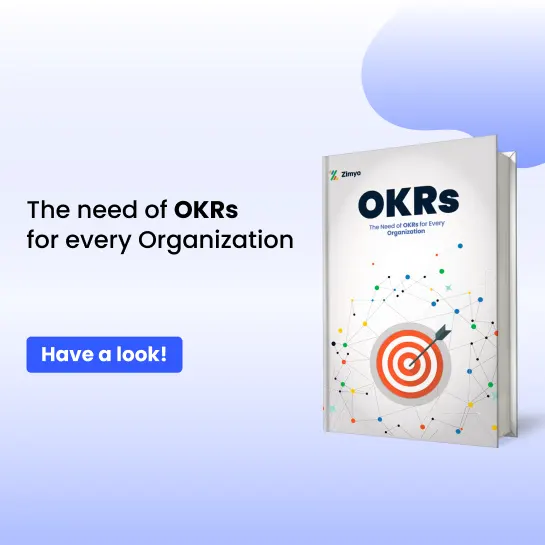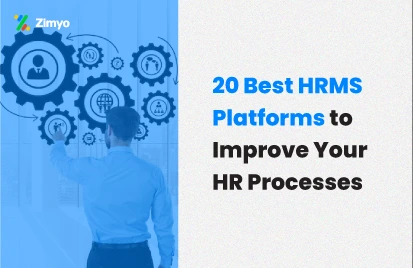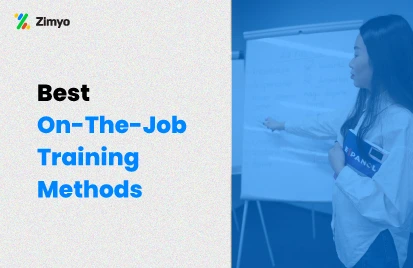Managing the leave policy of company is a basic HR job that every organisation must perform. A few typical doubts bother new start-up owners and newly minted HR managers. Will the skies collapse if we simply ignore this tedious task? What are the benefits of a leave policy?
The leave policy of company garners the most attention among all HR policies, right from the start. Because employees take leave on a regular basis, your company’s structure of leave policy is put to the test on regularly.
In this blog, we will dig deeper into all aspects of the structure of leave policy. It also suggests best practices for any professional to design an effective leave policy for your company.
But before we dive deeper, we need to know what a leave policy is:
What Is A Leave Policy?
A leave policy is a document that outlines the norms and procedures governing the various kinds of leaves that an employee may take.
A leave policy specifies the many types of leaves available for various occasions such as vacation, sickness, maternity, bereavement, and so on. It defines rules for many areas such as leave giving, eligibility, availing, encashment, and so on
Through its wording, tone, and friendliness quotient, the leave policy of company displays its professionalism and culture.
Importance Of A Good Structure Of Leave Policy
Employees have the right to leave, and the law binds the employers to provide it.
A lot of things happen in the lives of employees and their families outside of work. Birth, death, illness, or the need to care for a loved one: all of these events necessitate an employee’s absence from work.
Employees must also take time off to attend to personal affairs such as financial transactions, family gatherings, and so on. Employees require some relaxation for vacations and travel in order to refresh and return to work with newfound vigor.
Paid leaves assist employees in their time of need without causing them to lose wages. Paid holidays allow employees to relax and refresh. According to research, an employee-friendly leave policy increases staff satisfaction, loyalty, and performance.
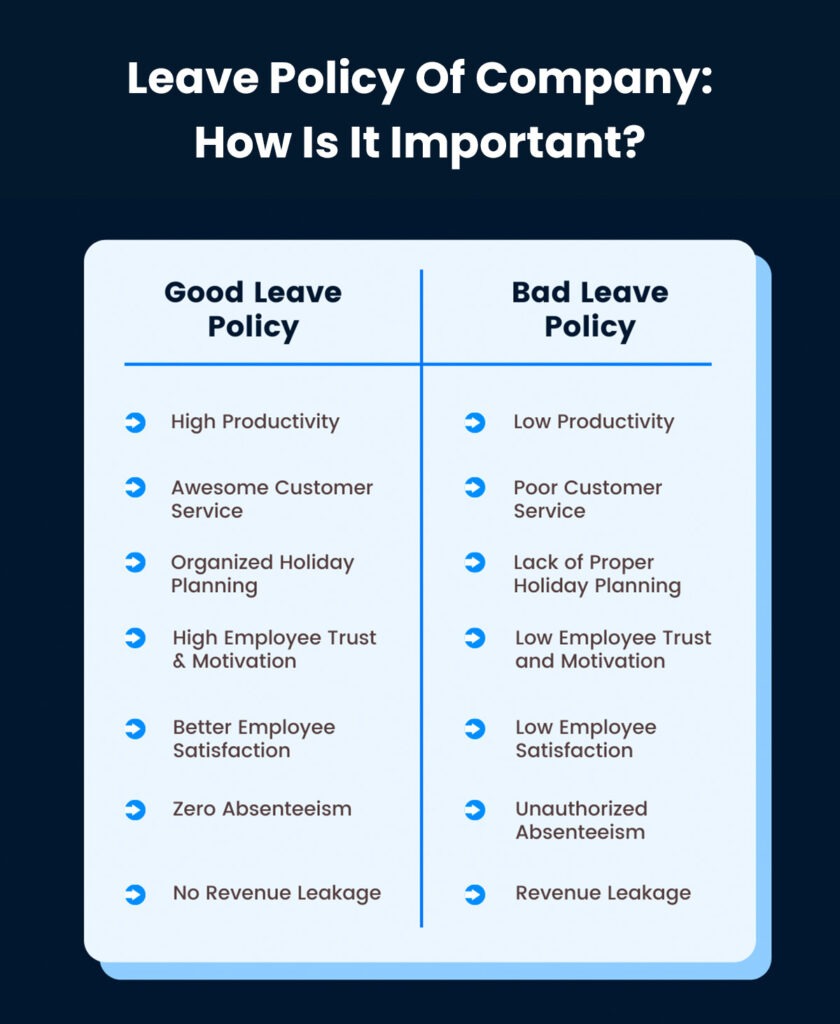
A leave policy is a must-have for efficient leave tracking in an organization. Various hurdles are eliminated by constructing an appropriate leave management system. These hurdles obstruct not just the leave monitoring system in an organization but the overall functioning too. A poor leave system affects a business in mysterious ways.
Having a clear and transparent leave policy and consistently enforcing it demonstrates the company’s professionalism. You encourage employee trust and happiness by establishing clear norms and ensuring transparency. All of this also contributes to the development of a strong employer brand.
Having a good structure of leave policy is a must for many reasons:
- For statutory compliance
- Record keeping
- Business operations & planning
- Reporting and analytics
- Prevent revenue leakage
How Do You Formulate A Leave Policy Of Company?
To create an effective leave policy of company, you must make the following decisions:
- The type of leave options.
- Set of rules and regulations for leaves.
- Your weekend policy.
- The calendar of public holidays.
According to the governing regulations, employees are entitled to paid leave in addition to public holidays. If an employee uses up all of their paid leave, they have the option of availing leave without pay.
Factors You Should Consider While Designing Structure Of Leave Policy
The basic factors to consider while designing the structure of leave policy are as follows:
Eligibility for Availing- The leave policy structured must define the eligibility criteria required for the employees to avail leaves. These criteria must take into account the different types of leaves: paid and unpaid.
This factor helps to shun the slow functioning of an organization due to repeated leaves taken by the employees. It also helps the employees avail leaves that they are entitled to without the fear of redundant denial of leave applications. Moreover, a budget can be created for the maximum paid leaves allowed per employee so that the organization does not suffer any financial imbalance.
Size of the Business- An organization must draft a flexible leave policy for SMEs and startups. The leave policy should be easily customizable. When an organization grows there are certain things that change and change in the leave policy is one such thing.
Working Process- Separate guidelines should be set for employees who follow different working schedules like people that work for only half-days, weekends, limited weekdays, remotely, full-time, etc. As the working procedure differs, so should the attendance and leave management.
Legal Laws- The government specified leave policies must be taken into account while structuring a leave policy. Such a step ensures minimum legal complications that must arrive due to poor leave management. Legal laws specify the important leaves that every company must provide like 26 weeks of maternity leaves, emergency medical leaves, etc.
Conclusive to the items addressed, with the constant work one puts on developing a business, structure of leave policy must also be given close attention.
Types Of Leaves In An Organisation
These are the different types of leaves in an organization:
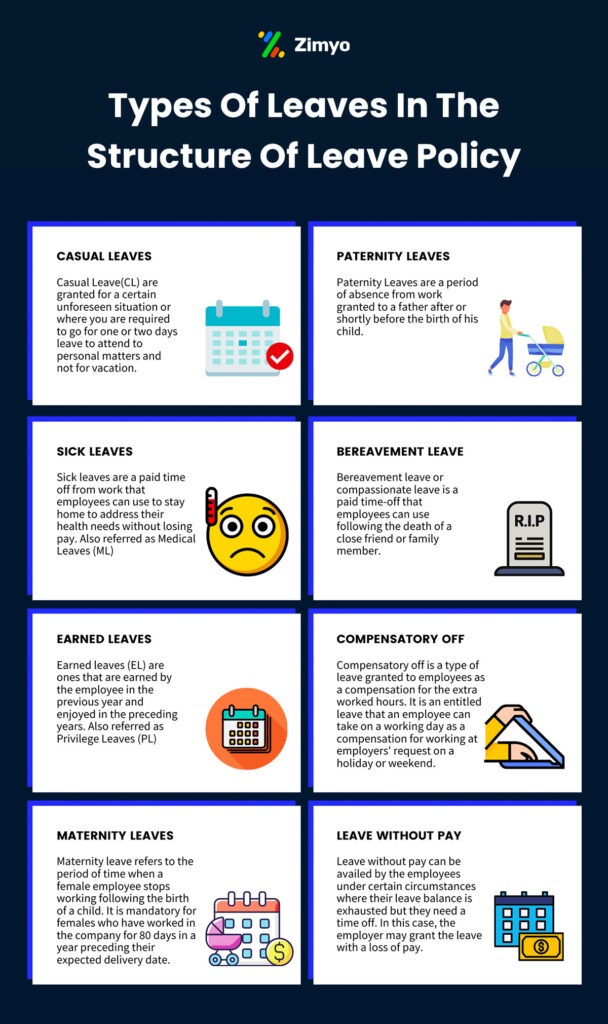
Privilege Leave (PL) or Earned Leave (EL)
Earned Leave is thus named because you ‘earn’ these days off for working.
The EL leave type is commonly utilized for personal reasons such as some urgent work, a one-day break, observing festivals that are not declared holidays, and so on.
Earned leaves are distinguished by the fact that the leave balance at the end of the leave year is carried forward to the following year. Moreover, state laws control the amount of leave that can be passed over to the next year.
Earned Leaves can also be converted to cash through a procedure known as Leave Encashment. The basic wage is typically regarded as the unit of exchange for encashment of leaves. One day’s EL amount equals one day’s basic salary.
Casual Leave (CL)
As opposed to EL, such leaves address any urgent personal needs.
Do you have an urgent plumbing issue at home? Do you need to go to your child’s school for some admissions-related work? Take a half or full day of CL to solve the problem.
If CL is not what you require for your business, you can just provide EL. It decreases the number of different types of leave and streamlines the leave policy of company.
Sick Leave (SL)
These are also known as Medical Leaves (ML) and are granted in the event of illness or an accident.
Sick Leave is another sort of leave that is a right for employees as the law states. Employers frequently seek a doctor’s note if the number of days on absence surpasses two or three days at a time, because these leaves are prone to misuse.
Maternity Leave (ML)
Maternity Benefit Act of 1961 entitles 26 weeks of paid leave to any female who has worked for at least 80 days in the 12 months preceding the projected delivery date.
While the prior types of leaves (AL/CL/SL) are under the control of state legislation, the Maternity Benefit Act is a federal law.
This leave is only applicable for the first two children. If you have a third kid, you can take 12 weeks off. The Act also mandates leave for miscarriage, adoption, surrogacy, and tubectomy.
Paternity Leave
The Paternity Leave is a leave granted to expectant fathers after the child’s birth. It is a leave of absence which employers provide to the father to care for the infant and the mother. As of now, there is no necessity in India’s labour regulations to give Paternity Leave.
However, many businesses provide Paternity Leave to their staff. The amount of leave available ranges from 2 days to 4 weeks and is entirely dependent on the employer’s policy. If the firm gives this form of leave, it must be used within a certain time frame.
Bereavement Leave
Bereavement Leave is a sort of leave that one can avail when there is a death in the family or the loss of a loved one. This vacation is usually for attending last rites or memorial services, attending to personal concerns, and, most significantly, grieving.
This form of leave is also known as compassionate leave. Compassionate leave, on the other hand, is granted not only for the death of a loved one, but also for the care of a dependent or an ill relative.
Employees in India are not bound by the law to take this form of leave. However, many forward-thinking firms provide bereavement leave ranging from 2 to 20 days.
Compensatory Off
If an employee works on a weekend or holiday due to the importance of the deliverables, they are eligible for a compensatory time off on any other weekday.
Because these leaves are dependent on business needs, they are granted on a case-by-case basis. There is a procedure for requesting and receiving comp-off leave.
After working on a non-working day, the employee must file a claim for comp time. The manager approves the request, which subsequently reaches to the HR. An employee gets a comp-off leave is once the HR approves it.
Leave Without Pay (LWP)
There are times when an employee’s leave balance is depleted yet he or she still needs time off for an emergency. In such cases, employers permit them to take unpaid vacation (LWP). Because there is a loss of income (LOP) when an employee takes this sort of leave, you can term it as LOP leave.
In the event of LOP leave, there is no notion of a leave balance. However, during payroll processing, we must withhold compensation for the number of days of LOP leave taken during the month.
Structure Of Leave Policy
The following major sections are the ones you can typically include in the structure of leave policy:
Objective – The policy’s objective encapsulates its intent. It usually states, “To outline the entitlements, procedures, and rules for employees to avail leave.”
Scope – This section restricts the policy’s recipients. The purview would primarily specify, “This policy applies to all personnel on the firm’s permanent payroll, including interns, probationers, and employees.”
Eligibility – This is typically a table that shows:
- Leaves of various kinds
- Annual entitlement/quota for each type of leave
- The amount of times (occasions) one can use a specific type of leave.
- The amount of leaves applicable per event.
- Leave time (minimum/maximum)
Procedure – This section explains how employees can use their leave. It is a series of steps that the employee, reporting management, reviewing manager (in certain cases), and the HR department must complete.
Guidelines – This is a comprehensive section that includes:
- Leave accrual process.
- Certain required provisions.
- Limits on the number of leaves that can be accumulated for each type of leave.
- Criteria for encashment, including relevant income tax.
- Provision for prefixing/suffixing holidays to leaves.
- Intervening holiday treatment.
- Documents required.
- Leaves that they can or cannot carry over to the next leave year.
- The effect on the notice period, if any, during a departure from the firm.
Exceptions – Usually, this part is at the end of the leave policy and states, “Any exceptions to this policy require the consent of the HR.”
When designing the leave policy of company, the HR must make a clear distinction between a policy and a process. The policy is “what and how many,” while the procedure is “how-to.”
Features Of A Good Leave Policy
A well-designed structure of leave policy includes the following elements:
- Includes version tracking data such as the effective date, revision number, and revision date.
- Divided rationally and contains numbered segments.
- The document should contain the name of the policy on each page.
- Takes the new updates into account.
- Uses simple language that is easy to read and remains consistent throughout.
- Features keywords that are properly defined to ensure that there is no misunderstanding.
- It is multilingual and is written in English as well as the local language of the particular area. This aids in the policy’s relevant communication.
- Protects the corporation from potential lawsuits.
- Has a set review and audit period, which is usually every two years.
- Explains and communicates with the employee.
Final Words
The procedure of availing leaves, rather than the types and amount of leaves, impacts the employees’ view of how “friendly” the leave policy of company is.
Keep in mind that you can use a good structure of leave policy to express the company’s views and values. Leave policy is about more than just providing vacations; it is about educating employees about their benefits and making it easy for them to use them efficiently.
The true test of a good leave policy is the results it yields: happy and engaged employees with a solid work-life balance.

